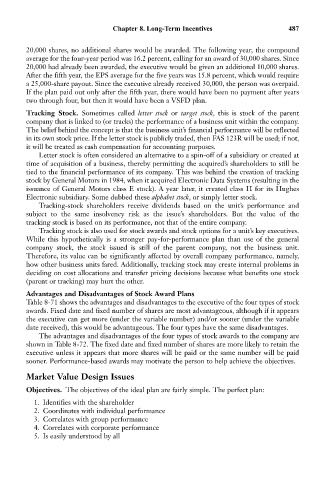Page 501 - Bruce Ellig - The Complete Guide to Executive Compensation (2007)
P. 501
Chapter 8. Long-Term Incentives 487
20,000 shares, no additional shares would be awarded. The following year, the compound
average for the four-year period was 16.2 percent, calling for an award of 30,000 shares. Since
20,000 had already been awarded, the executive would be given an additional 10,000 shares.
After the fifth year, the EPS average for the five years was 15.8 percent, which would require
a 25,000-share payout. Since the executive already received 30,000, the person was overpaid.
If the plan paid out only after the fifth year, there would have been no payment after years
two through four, but then it would have been a VSFD plan.
Tracking Stock. Sometimes called letter stock or target stock, this is stock of the parent
company that is linked to (or tracks) the performance of a business unit within the company.
The belief behind the concept is that the business unit’s financial performance will be reflected
in its own stock price. If the letter stock is publicly traded, then FAS 123R will be used; if not,
it will be treated as cash compensation for accounting purposes.
Letter stock is often considered an alternative to a spin-off of a subsidiary or created at
time of acquisition of a business, thereby permitting the acquired’s shareholders to still be
tied to the financial performance of its company. This was behind the creation of tracking
stock by General Motors in 1984, when it acquired Electronic Data Systems (resulting in the
issuance of General Motors class E stock). A year later, it created class H for its Hughes
Electronic subsidiary. Some dubbed these alphabet stock, or simply letter stock.
Tracking-stock shareholders receive dividends based on the unit’s performance and
subject to the same insolvency risk as the issue’s shareholders. But the value of the
tracking stock is based on its performance, not that of the entire company.
Tracking stock is also used for stock awards and stock options for a unit’s key executives.
While this hypothetically is a stronger pay-for-performance plan than use of the general
company stock, the stock issued is still of the parent company, not the business unit.
Therefore, its value can be significantly affected by overall company performance, namely,
how other business units fared. Additionally, tracking stock may create internal problems in
deciding on cost allocations and transfer pricing decisions because what benefits one stock
(parent or tracking) may hurt the other.
Advantages and Disadvantages of Stock Award Plans
Table 8-71 shows the advantages and disadvantages to the executive of the four types of stock
awards. Fixed date and fixed number of shares are most advantageous, although if it appears
the executive can get more (under the variable number) and/or sooner (under the variable
date received), this would be advantageous. The four types have the same disadvantages.
The advantages and disadvantages of the four types of stock awards to the company are
shown in Table 8-72. The fixed date and fixed number of shares are more likely to retain the
executive unless it appears that more shares will be paid or the same number will be paid
sooner. Performance-based awards may motivate the person to help achieve the objectives.
Market Value Design Issues
Objectives. The objectives of the ideal plan are fairly simple. The perfect plan:
1. Identifies with the shareholder
2. Coordinates with individual performance
3. Correlates with group performance
4. Correlates with corporate performance
5. Is easily understood by all

